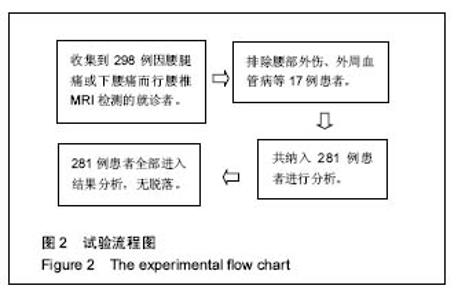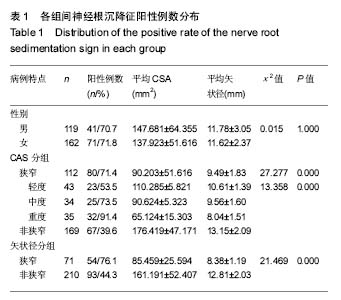| [1] Amundsen T, Weber H, Nordal HJ, et al. Lumbar spinal stenosis: conservative or surgical management?: A prospective 10-year study. Spine (Phila Pa 1976). 2000;25(11):1424-1435, 1435-1436.[2] Andreisek G, Imhof M, Wertli M, et al. A systematic review of semiquantitative and qualitative radiologic criteria for the diagnosis of lumbar spinal stenosis. AJR Am J Roentgenol. 2013;201(5):W735-W746.[3] de Schepper EI, Overdevest GM, Suri P, et al. Diagnosis of lumbar spinal stenosis: an updated systematic review of the accuracy of diagnostic tests. Spine (Phila Pa 1976). 2013; 38(8):E469-E481.[4] Barz T, Melloh M, Staub LP, et al. Nerve root sedimentation sign: evaluation of a new radiological sign in lumbar spinal stenosis. Spine (Phila Pa 1976). 2010;35(8):892-897.[5] Fazal A, Yoo A, Bendo JA. Does the presence of the nerve root sedimentation sign on MRI correlate with the operative level in patients undergoing posterior lumbar decompression for lumbar stenosis? Spine J. 2013;13(8):837-842.[6] Barz T, Melloh M, Staub LP, et al. Increased intraoperative epidural pressure in lumbar spinal stenosis patients with a positive nerve root sedimentation sign. Eur Spine J. 2014;23(5):985-990.[7] Takahashi K, Miyazaki T, Takino T, et al. Epidural pressure measurements. Relationship between epidural pressure and posture in patients with lumbar spinal stenosis. Spine (Phila Pa 1976). 1995;20(6):650-653.[8] Takahashi K, Kagechika K, Takino T, et al. Changes in epidural pressure during walking in patients with lumbar spinal stenosis. Spine (Phila Pa 1976). 1995;20(24): 2746-2749.[9] Zhang L, Chen R, Liu B, et al. The nerve root sedimentation sign for differential diagnosis of lumbar spinal stenosis: a retrospective, consecutive cohort study. Eur Spine J. 2016.[10] Tomkins-lane CC, Quint DJ, Gabriel S, et al. Nerve root sedimentation sign for the diagnosis of lumbar spinal stenosis: reliability, sensitivity, and specificity. Spine (Phila Pa 1976). 2013;38(24):E1554-E1560.[11] Benditz A, Grifka J, Matussek J. Lumbale Spinalkanalstenose. Zeitschrift für Rheumatologie.2015;74(3):215-225.[12] Genevay S, Atlas SJ. Lumbar Spinal Stenosis. Best Prac Res Clin Rheumatol. 2010;24(2):253-265.[13] Eun SS, Lee HY, Lee SH, et al. MRI versus CT for the diagnosis of lumbar spinal stenosis. J Neuroradiol. 2012;39(2):104-109.[14] Kuittinen P, Sipola P, Leinonen V, et al. Preoperative MRI Findings Predict Two-Year Postoperative Clinical Outcome in Lumbar Spinal Stenosis. PLoS One. 2014;9(9):e106404.[15] 柳扬,郝敬东,崔准,等. 神经根沉降征在中央型腰椎管狭窄症诊断中的初步研究[J]. 中华骨与关节外科杂志, 2016,9(4): 303-307.[16] Macedo LG, Wang Y, Battie MC. The sedimentation sign for differential diagnosis of lumbar spinal stenosis. Spine (Phila Pa 1976). 2013;38(10):827-831.[17] 田鹏, 付鑫, 孙晓雷, 等. 神经根沉降征在腰椎滑脱症和腰椎间盘突出症中的差异[J]. 天津医药, 2014,42(12):1216-1219.[18] Burgstaller JM, Schüffler PJ, Buhmann JM, et al. Is There an Association Between Pain and Magnetic Resonance Imaging Parameters in Patients With Lumbar Spinal Stenosis?. Spine. 2016;41(17):E1053-E1062.[19] Weber C, Giannadakis C, Rao V, et al. Is There an Association Between Radiological Severity of Lumbar Spinal Stenosis and Disability, Pain, or Surgical Outcome? Spine. 2016;41(2):E78-E83.[20] Hong JH, Lee MY, Jung SW, et al. Does spinal stenosis correlate with MRI findings and pain, psychologic factor and quality of life? Korean J Anesth. 2015;68(5):481.[21] 张楠, 刘娜, 丑凯平, 等. 神经根沉降征与重度中央型/混合型腰椎管狭窄受压节段硬膜囊横截面积变化的相关性研究[J]. 中国脊柱脊髓杂志, 2016,26(10):919-925.[22] Thome C, Borm W, Meyer F. Degenerative lumbar spinal stenosis: current strategies in diagnosis and treatment. Dtsch Arztebl Int. 2008;105(20):373-379.[23] Ganz JC. Lumbar spinal stenosis: postoperative results in terms of preoperative posture-related pain. J Neurosurg. 1990;72(1):71-74.[24] Kim HJ, Park JY, Kang KT, et al. Factors influencing the surgical decision for the treatment of degenerative lumbar stenosis in a preference-based shared decision-making process. Eur Spine J. 2015;24(2):339-347.[25] Kim YU, Kong Y, Lee J, et al. Clinical symptoms of lumbar spinal stenosis associated with morphological parameters on magnetic resonance images. Eur Spine J. 2015;24(10): 2236-2243.[26] Laudato PA, Kulik G, Schizas C. Relationship between sedimentation sign and morphological grade in symptomatic lumbar spinal stenosis. Eur Spine J. 2015;24(10):2264-2268.[27] 杨军,洪正华,王跃.神经根沉降征及其临床意义的研究进展[J]. 中国脊柱脊髓杂志, 2015,25(6):563-566.[28] 陈佳, 赵凤东, 范顺武. 马尾沉降征在腰椎管狭窄症诊断中的价值[J]. 中华骨科杂志, 2015,35(6):636-642.[29] Barz C, Melloh M, Staub LP, et al. Reversibility of nerve root sedimentation sign in lumbar spinal stenosis patients after decompression surgery. Eur Spine J. 2017.[30] Zhang L, Chen R, Xie P, et al. Diagnostic value of the nerve root sedimentation sign, a radiological sign using magnetic resonance imaging, for detecting lumbar spinal stenosis: a meta-analysis. Skeletal Radiol. 2015;44(4):519-527.[31] Lee J, Koh S, Jung H, et al. Can MRI Findings Help to Predict Neurological Recovery in Paraplegics With Thoracolumbar Fracture?. Ann Rehabil Med. 2015;39(6):922. |



